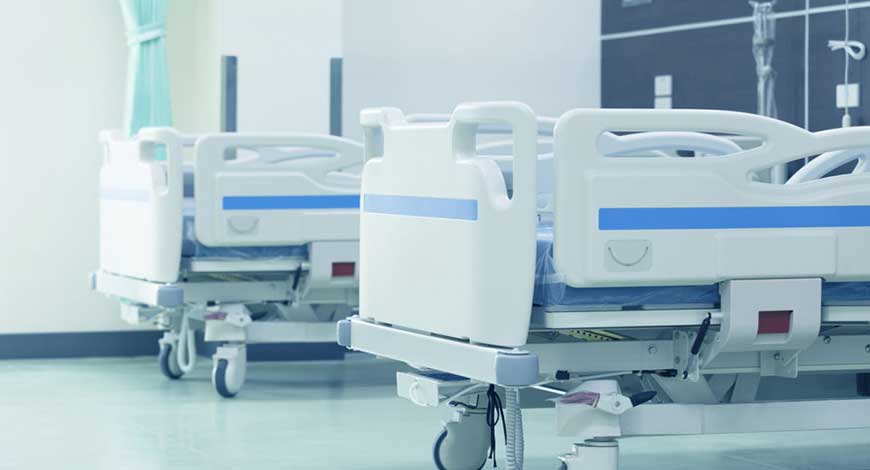As Donald Trump and Republican lawmakers ponder how best to cut Medicaid in order to pay for new tax boons for the rich, doctors, hospital executives, and advocates are warning that changes to the nation’s health insurance program for the poor could harm patients, quickly cause rural hospitals to close, and force essential programs to shut down.
For months now, the Trump administration has been exploring ways to pay off the massive $4.5 trillion loss of tax revenue it would incur by making Trump’s 2017 tax cuts permanent. So far, House Republicans‘ initial reconciliation bill has demanded $1.7 trillion in spending cuts across a slew of committees and government sectors. The biggest concern for health care professionals is the $880 billion the House Energy and Commerce Committee has been instructed to slash from its budget. While Trump has repeatedly pledged not to cut Medicaid, there is virtually no way for Republican lawmakers to achieve their target without massive cuts to the program tens of millions of Americans rely on for health care.
Conservatives appear ready to eliminate a key funding mechanism, called provider taxes, that have allowed states to provide supplemental payments to hospitals, doctors, and other providers in order to make up for lower reimbursements from Medicaid. According to an April report from The Wall Street Journal, delays in the processing of such payments by the Centers for Medicare and Medicaid Services have already forced hospitals in several states to lay off staff and pause payments to suppliers as the agency slow-walks supplemental funding approvals.
Republicans are also reportedly pushing to impose work requirements on most able-bodied Medicaid beneficiaries without dependents — demanding they work, volunteer, or go to school for 80 hours a month — while checking recipients’ income more frequently. The changes will add more bureaucratic bloat to a program riddled with it, and could lead to coverage losses.
Democrats are warning that Republicans’ proposed health care cuts will cause millions to lose their insurance coverage. New Mexico Governor Michelle Lujan Grisham (D) said Sunday that if Trump and Republican lawmakers cut Medicaid, “People will die. Children will die.” Rep. Alexandria Ocasio-Cortez (D-N.Y.) told Rolling Stone that Republicans are trying “to gut what is left of the health care and social safety net in the United States,” in order to fund tax cuts for their donors.
The health care industry is sounding the alarm about proposed Medicaid cuts, too.
In an April letter to Republican and Democratic congressional leadership, the American Hospital Association — a health care lobby representing over 5,000 hospital networks and two million health care workers — urged Congress to “refrain from considering disruptive policy changes to Medicaid and other health care coverage that could impact access to health care for tens of millions of Americans.”
The AHA pointed to not just the sum total of proposed cuts, but specific policy changes Republicans are floating that could result in hospitals getting less money, fewer Americans qualifying for benefits, and some patients covering more of their health care costs.
The association warned about “harmful reductions to federal Medicaid spending” under consideration in Congress. “These include changing the underlying finance structure to a per capita cap, reducing the federal medical assistance percentage (FMAP) for certain states, and placing new limits on provider taxes. Any of these changes would negatively impact state financing for their Medicaid programs, which in turn would harm hospitals and Medicaid beneficiaries,” the AHA wrote. “Should states see reductions in federal support for their Medicaid programs, it could force them to further reduce provider payments to account for these losses.”
The AHA further warned of policies “that could result in the displacement of Medicaid coverage for millions of beneficiaries and could lead to additional uncompensated care for our facilities.” Proposals under consideration reportedly include making some Medicaid beneficiaries pay higher premiums or co-pays for medical visits. Republicans appear to have coalesced behind the idea of imposing work requirements for able-bodied adults under 65 years of age who do not have dependents.
During the AHA’s annual meeting in Washington, D.C., last week, “uncertainty” was the word of the moment.
Amid the ever-shifting sands of the Trump administration — where policy is shaped less by legislation than by executive orders, televised declarations, and impulsive Truth Social posts — hospital executives, doctors, and industry lobbyists have struggled to get a handle on what the administration has planned for health care. One thing is abundantly clear: What seems to be on the table is bad for the nation’s poor — and for its businesses.
“Hospitals go out of business when Medicare and Medicaid are cut. Period,” one attendee tells Rolling Stone.
Troy Clark, president and CEO of the New Mexico Hospital Association, is worried about what cuts to Medicaid and Medicare could mean for rural hospitals in his state, which are often the only connection entire communities have to the nation’s health care system. Cuts to funding and limitations on access to Medicaid would ripple throughout the entire state, where over 40 percent of the population is enrolled in the program.
“I have probably between six and eight hospitals in New Mexico that if the supplemental payments are cut, they will probably close in the next 12 to 18 months,” Clark tells Rolling Stone. “They’re rural, they’re small, and they have a high percentage [of Medicaid patients]. I have several counties that are 80-percent-plus Medicaid, and so that means [the hospital is] probably 95-percent Medicaid plus Medicare. They’re not vibrant economic communities that have employers, so they rely on this, and if they go back to where they were before the supplemental payments, they’ll have to close their doors. They can’t stay open.”
“Words matter when it comes to politicians, and they will say things [in a] very couched [way]. So, ‘We’re not going to touch the Medicaid program.’ Well, does that mean to beneficiaries, or does that mean to the reimbursement to hospitals and doctors?” Clark adds of the messaging coming from Republicans.
Dr. Michael Brown, the chief medical officer and a pulmonary specialist at Colquitt Regional Medical Center in Georgia, says that hospitals like his would be severely impacted by the proposed cuts.
“We would all agree that there are big problems in health care that need addressing,” he says. “But you can’t just cut the funding that these hospitals are dependent upon.”
“You have to be careful what you’re going to compromise,” Brown adds. “And loss of health care, particularly in rural societies that really depend on it — both for health care and for jobs — without those entities, without having solvent hospitals in rural communities, those communities are in peril.”
Jessica Rivenbank, vice president of medical education at Colquitt Regional Medical Center, says the proposed cuts would also place critical programs, like those supporting obstetric and psychiatric programs at hospitals like theirs, at risk.
Republicans have framed Medicaid work requirements as one way to slash costs without harming beneficiaries who need it.
“You don’t want able-bodied workers on a program that is intended, for example, for single mothers with two small children who [are] just trying to make it,” House Speaker Mike Johnson (R-La.) said earlier this year. “That is what Medicaid is for. Not for 29-year-old males sitting on their couches playing video games.”
Data indicates most Medicaid enrollees already do, in fact, work. Imposing work requirements would add extra layers of bureaucracy to a program that already sees many eligible beneficiaries lose their benefits for administrative reasons.
Medicaid is aggressively means-tested; Americans are ineligible for the program if they earn near enough money to get by on their own. States are required to check beneficiaries’ income annually to make sure they are still poor, and these checks frequently lead to eligible beneficiaries having their coverage terminated because they missed a phone call or failed to respond to a piece of mail.
Given Medicaid’s strict income limits, imposing work requirements would likely force people to toil in low-wage jobs, or apparently volunteer, if they want to maintain their health coverage — and it would certainly lead to more beneficiaries losing their coverage for bureaucratic reasons.
When Arkansas attempted to impose similar work requirements during Trump’s first term, it “substantially exacerbated administrative hurdles to maintaining coverage,” according to a study in the New England Journal of Medicine.
Conducting more frequent checks on beneficiaries’ income — another idea that Republicans have rallied behind — proved to be a disaster when Georgia tried it, according to reporting by ProPublica.
Lost in the conversation about forcing supposedly able-bodied Medicaid recipients to work is the fact that many beneficiaries cannot work, but haven’t been approved for disability, which is an arduous process.
American Hospital Association attendees who spoke to Rolling Stone said they felt that the administration’s focus on the imagined 29-year-old couch potato as the emblem of fraud, waste, and abuse in the medical system was misguided, and that work requirements would do little more than unnecessarily exclude people from the system.
“A lot of the patients who are on Medicaid can’t work,” says Brown, the Colquitt Regional Medical Center chief medical officer. “A lot of the people who are in a borderline poverty scenario, or are impoverished, or have health care conditions that do keep them from being able to work, many of them are dependent upon Medicaid.”
Former Trump White House adviser and Republican pollster Kellyanne Conway spoke to the AHA last week and applauded Speaker Johnson’s approach toward Medicaid and work requirements.
Conway said onstage that Medicaid should be reserved for people like a “single mom of two, who’s doing everything she can to keep it together and keep those kids nourished, healthy, safe.” She explained, “I was raised by that kind of mom.”
The program shouldn’t be for “the 29-year-old on the sofa” who is able-bodied and refuses to find a job, she added.
Based on Medicaid’s income limits, an adult living in California without dependents cannot earn more than $21,597 — which is less than Conway’s reported fee for speaking at events like the AHA conference. (Conway has spoken at several recent lobbying group events.)
Clark, who leads the New Mexico Hospital Association, sees the talk about 29-year-old sofa surfers on Medicaid as a distraction.
“Get rid of the 29-year-old sitting on mom and dad’s couch who has no interest in paying his own way. Get rid of the person who no longer is eligible and is still drawing on the system,” he says. Does fraud exist in the system? “Clearly it does,” Clark concedes, but it’s realistically “a very small fraction that might cost us a lot more to go find” than what these cuts would truly eliminate.
What is of bigger concern to people like Clark is the reality that a mass cut to Medicaid’s already rickety funding system — flawed as it may be — could lead to catastrophic outcomes for patients throughout the country.
If legislators want to cut Medicaid supplemental funding, and then “stand there and present it as if we’ve done great eliminating waste. It’s like, no, you haven’t,” Clark said. “You have eliminated the ability for access to care. Without the add-ons, doctors aren’t going to supply the services, and hospitals can’t afford to. They won’t be able to stay open.” Rollingstone








